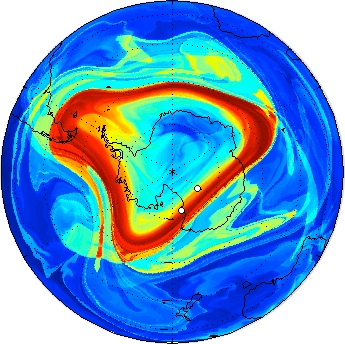ACADEMIA
Climate change: CSIC, CESGA investigate the causes of the Antarctic ozone hole
- CSIC scientists use the Finis Terrae to study the influence of the polar vortex winds system in the formation of the Antarctic ozone hole.
- This is a phenomenon of particle dispersion in the atmosphere similar to that produced by the ashes of volcanic eruptions, such as Eyjafjalla Icelandic volcano that paralyzed European air space two years ago.
Research by scientists at the Institute of Mathematical Sciences (ICMAT CSIC) studied the relationship between the Antarctic winds and the hole in the ozone layer. The study of such a complex phenomenon has needed the development of new computational tools. The Finisterrae supercomputer at CESGA is responsible for the calculations.
The polar vortex is a cyclonic circulation system centered at the South Pole, bounded by a jet stream on its border that acts as a barrier to particle transport, inhibiting air exchange between the inside and outside. Currently, it is estimated that this isolation affects the conditions of the formation of the Antarctic ozone hole, and so the importance of this phenomenon and others like it makes it the object of analysis for the Institute of Mathematical Sciences (ICMAT) National Research Council (CSIC), with the support of the Supercomputing Center of Galicia (CESGA) for their studies.
Dispersion of particles
“The dispersion, transport, mixing of particles in fluids is a phenomenon with important applications. Its optimization or inhibition interested in fields as diverse as microfluidics, marine science or weather," said Dr. Ana Maria Mancho Sanchez, ICMAT, who puts a very concrete example of the importance of investigating these phenomena, "the ashes dumped into the atmosphere by the Icelandic volcano Eyjafjalla scattered by the atmosphere, and in doing so paralyzed the European airspace for several days in 2010. Finding patterns of order in apparent disorder of the dispersion of these particles was and remains a challenge, for greater accuracy in predictions have saved many millions of euros for the airline companies.
"The work is carried out using the supercomputer capacity of Finis Terrae at CESGA, by Dr. Ana Maria Mancho and colleagues, Álvaro de la Cámara, Jezabel Curbelo and Carolina Mendoza have addressed these problems in various oceanic and atmospheric contexts, for which they have developed new tools. In particular, the studies from Álvaro de la Cámara and researchers from other centers have focused "in the Southern Hemisphere stratosphere." In it, Dr. Mancho recalls, "is the polar vortex."
The study of the dynamics of the polar vortex "intensified after the discovery of the 'ozone hole' in the Antarctic stratosphere, it is thought that the insulation inside the air affects the conditions of its formation," says the scientist.
The work at CESGA "has focused on the application of new mathematical tools for the reanalysis of the Antarctic vortex data have provided a clear framework that reveals dynamic transport routes through the vortex, and have been contrasted with data balloons from the VORCORE y CONCORDIASI experimental campaigns," he concludes.
Para mayor información
Teléfono: 912999762 a.m.mancho@icmat.es Links a publicaciones especializadas:
a) Routes of Transport across the Antarctic Polar Vortex in the Southern Spring http://journals.ametsoc.org/doi/abs/10.1175/JAS-D-11-0142.1
b) Hidden Geometry of Ocean Flows http://prl.aps.org/abstract/PRL/v105/i3/e038501
c) The turnstile mechanism across the Kuroshio current: analysis of dynamics in altimeter velocity fields http://www.nonlin-processes-geophys.net/17/103/2010/npg-17-103-2010.pdf
